Histoire

histoire poésie
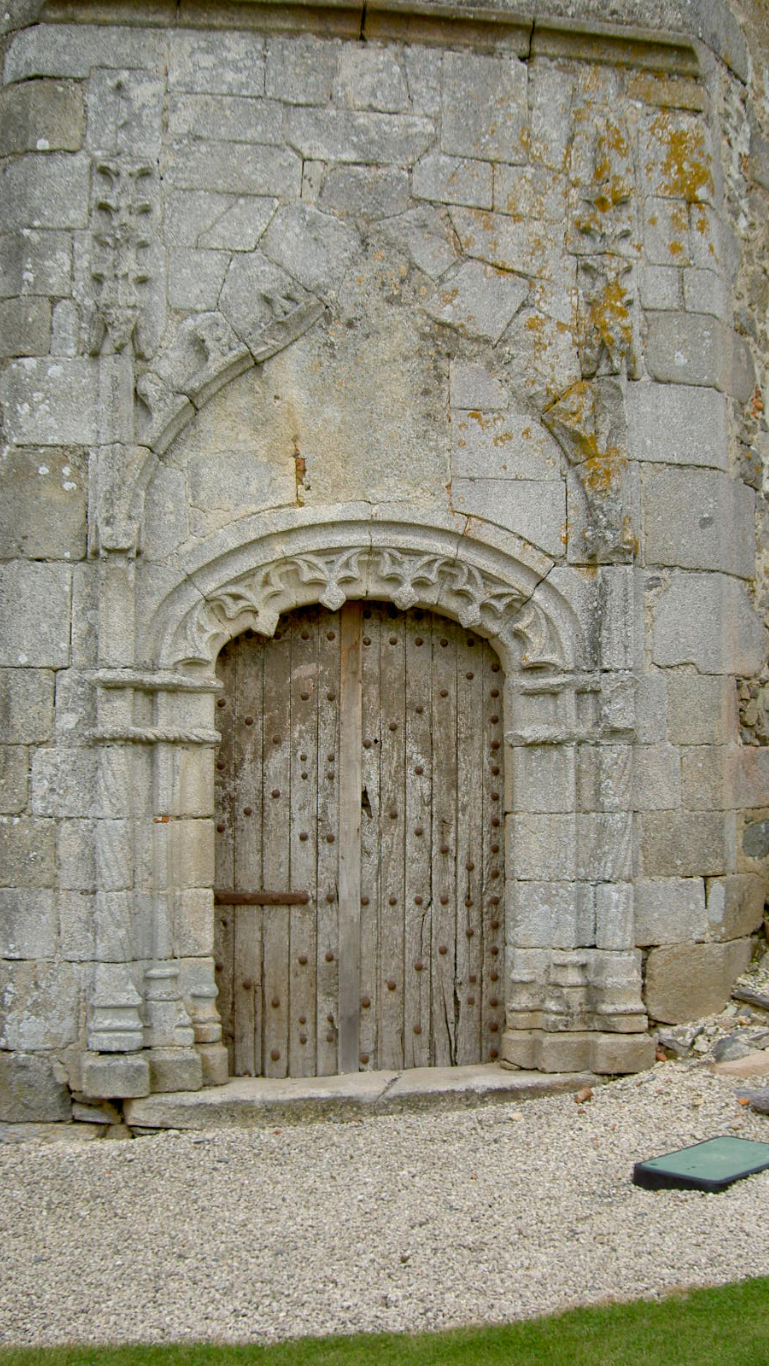
Entrez dans l'histoire
Les premières traces du château de la Ménardière datent du XIVe siècle, où il fut bâti par la famille Mesnard. Pourtant, ce ne fut qu’aux XVe et XVIe siècles que le bâtiment prit une forme plus moderne, avec les constructions de la famille Grignon. Elle y fit construire le grand escalier et la tour qui forment aujourd’hui la plus grande partie du château. À la fin du XVIe siècle, il fut le témoin des guerres de religions, passant des mains protestantes à celle des catholiques et vice-versa. La Ménardière a souvent changé de famille, ou de branche familiale, que ce soit par héritage ou par vente. Incendié par les colonnes infernales du général Turgot durant la Révolution, ce château ne fut restauré, partiellement, qu’à la fin du XXe siècle où il devint tel qu’on peut le voir aujourd’hui.
En savoir plus ...
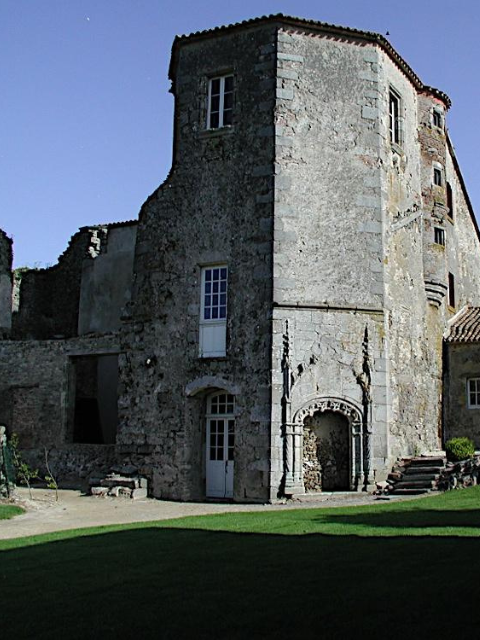
Extraits du livre de M. de Raigniac De Châteaux en logis
La Mesnardière fut évidemment fondée par des Mesnard dès avant le XIV° siècle. Quoi qu’il en soit, les premiers seigneurs connus de la Mesnardière sont les Grignon. On sait seulement que dès 1403, André Grignon, fils de Jean Grignon, déjà seigneur de Breuil Bastard, à la Tardière, est seigneur de la Mesnardière.
Le dernier des Grignon de la Mesnardière fut François Grignon. Celui-ci fut assassiné vers 1529 par Gilles et Jacques de Faubert, seigneurs de la Vergne à Secondigny. Ces derniers furent condamnés à être décapités et leurs biens confisqués. Cette sentence fut rapidement suivie de lettres de grâces. François Grignon était alors père d’une fille mariée depuis quelques années à Louis Bigot. Tout fait penser que François Grignon fit construire la tour et l’escalier de la Mesnardière. Les armes des Grignon y sont nombreuses et toutes en premières places.
Louis Bigot qui en 1531 est veuf de Catherine Grignon descend d’un maire de Poitiers en 1372. Sa famille est riche.Les nouveaux seigneurs de la Mesnardière sont donc les Bigot. Ils possèdent en outre la seigneurie de la Girardie à Sérigné où ils édifieront une fort belle demeure.
La Mesnardière passe à leur second fils François Bigot. Il est catholique et capitaine d’une compagnie d’ordonnances du Roi Charles IX. En mai 1574, il assiège le château de la Forêt-sur-Sèvre, occupé par les protestants parmi lesquels se trouve son gendre, René Bastard de la Cressonnière. Les protestants paraissent les moins nombreux et disposés à se rendre. François Bigot vient se présenter en tant que parlementaire. Il est tué. Il se trouvait alors entre les deux ponts du château et ce meurtre était « contre tout droit de guerre » On ne se gêna pas pour accuser René Bastard d’avoir voulu faire assassiner son beau-père.
Il était pressé de le voir disparaître et lui reprochait d’avoir donné La Girardie à sa fille cadette Anne. Sa propre femme Charlotte Bigot était l’aînée des deux sœurs et il estimait que son père aurait dû lui donner la Girardie en plus de La Mesnardière. Le 7 novembre 1579 René Bastard sera condamné à mort par la Cour des Grands Jours de Poitiers. La sentence ordonne que les châteaux de La Mesnardière et de la Cressonnière, tous deux appartenant à René Bastard soient rasés… Ce n’est que deux ans plus tard que René Bastard fut tué dans un combat près de Richelieu.
La Mesnardière sera jusqu’à la Révolution la résidence principale des héritiers de René Bastard. Ces derniers seront des personnages riches et puissants. Son fils Henry Bastard sert Henri IV avec fidélité. Il sera chevalier de l’ordre du Roi et Gouverneur de Maillezais. Sa femme Louise de Pontlevoye lui porte le charmant château de la Blandinière près de Mauléon et d’autres biens. Mais les Bastard sont restés protestants et, à la génération suivante, les deux fils d’Henry Bastard suivront Soubise dans sa révolte contre Louis XIII. L’aîné sera tué lors de la bataille de Mareuil.
La Mesnardière et la plus grande partie de l’héritage des Bastard va revenir à la fille aînée Louise. Comme la plupart de ses frères et sœurs, elle est née à la Mesnardière. Elle a épousé Louis Maistre qui est seigneur de la Papinière et d’Aizenay. Leurs descendants, les Maistre puis les La Tour vont vivre à la Mesnardière.
En 1734, leur héritière, Henriette-Catherine de La Tour épouse Louis-Henri d’Asnieres, seigneur de Lucques. C’est un voisin qui réside au petit château de Lucques à la limite de Menomblet et de Saint-Marsault. C’est peu de chose à côté de la Mesnardière et les d’Asnieres vont désormais habiter la Mesnardière. C’est à cette époque, au 18° siècle, que les d’Asnieres remanient profondément l’architecture du château et de ses dépendances. Leur fils Jean d’Asnieres se trouve à la tête d’une fortune considérable. Il obtient l’érection en marquisat d’Asnieres-la Chataigneraie, de ses terres du Petit château de Vouvant, de La Chataigneraie, de la Mesnardière, Saint-Pierre-du -Chemin et Menomblet. Jean d’Asnieres épouse en 1784 Mademoiselle Catherine de Montmorin. Ils habitent la Mesnardière où vont naître leurs enfants. La Révolution arrive et Jean d’Asnieres émigre. Sa femme et ses enfants demeurent d’abord à la Mesnardière puis se retirent en Normandie. Le château est incendié lors du passage des colonnes infernales.
Toutes les terres de Jean d’Asnieres ont été confisquées comme biens d’émigrés. Elles seront mises en adjudication le 9 Pluviôse an IV (29 janvier 1796). Grâce à un prête-nom, la citoyenne Catherine Arnaude de Montmorin, femme de Jean d’Asnieres a le droit de racheter le « ci-devant château de la Mesnardière, incendié ». Ainsi La Mesnardière revient aux d’Asnieres. On peut penser qu’ils procédèrent à quelques réparations sommaires afin de pouvoir y faire quelques séjours mais en temps normal ils habitent Paris. Le dernier des d’Asnieres à posséder la Mesnardière sera le comte Raymond d’Asnieres qui épouse Mlle Morin de Banneville. Cette dernière meurt veuve en 1881. Elle a fondé à Saint-Pierre-du-Chemin un hôpital. Elle sera inhumée dans la chapelle de ce dernier ainsi que son mari ; on y transportera également les corps de ses beaux-parents.
La Mesnardière a été achetée en 1869 par Edmond Savary de Beauregard, de la branche du Chastenay à La Chataigneraie, qui s’intéressait essentiellement aux terres qui l’entouraient. Le château ne fut pas habité par sa famille et tomba en ruines. La Ménardière passera par héritage à ses descendants directs, les La Barre de Nanteuil, puis les du Plessis de Grenédan qui la restaureront partiellement à partir de 1998.
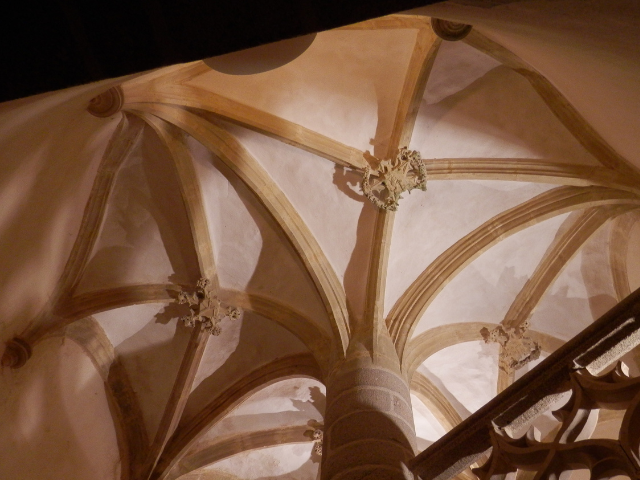
... et la poésie.
A qui s’en sera enquis, Il faudra qu’on réponde :
Voici une métairie, dans la Vendée profonde.
“Une métairie dites-vous ? plutôt une seigneurie”
Eh oui, c’était les deux, du temps que les seigneurs
N’étaient pas à Versailles à chercher les honneurs.
Nous sommes dans le bocage, c’était un vieux château.
Les ans, et puis les guerres, la pluie, les incendies
Rabattirent sa fierté. Il tomba dans l’oubli.
Longtemps il attendit que cessent tous ces maux.
Le Puy du Fou, Maillezais, La Chabotterie, Fontenay
Tour à tour se relèvent, tour à tour se réveillent.
Usant ses dernières forces, la Ménardière aussi …
Histoire du château
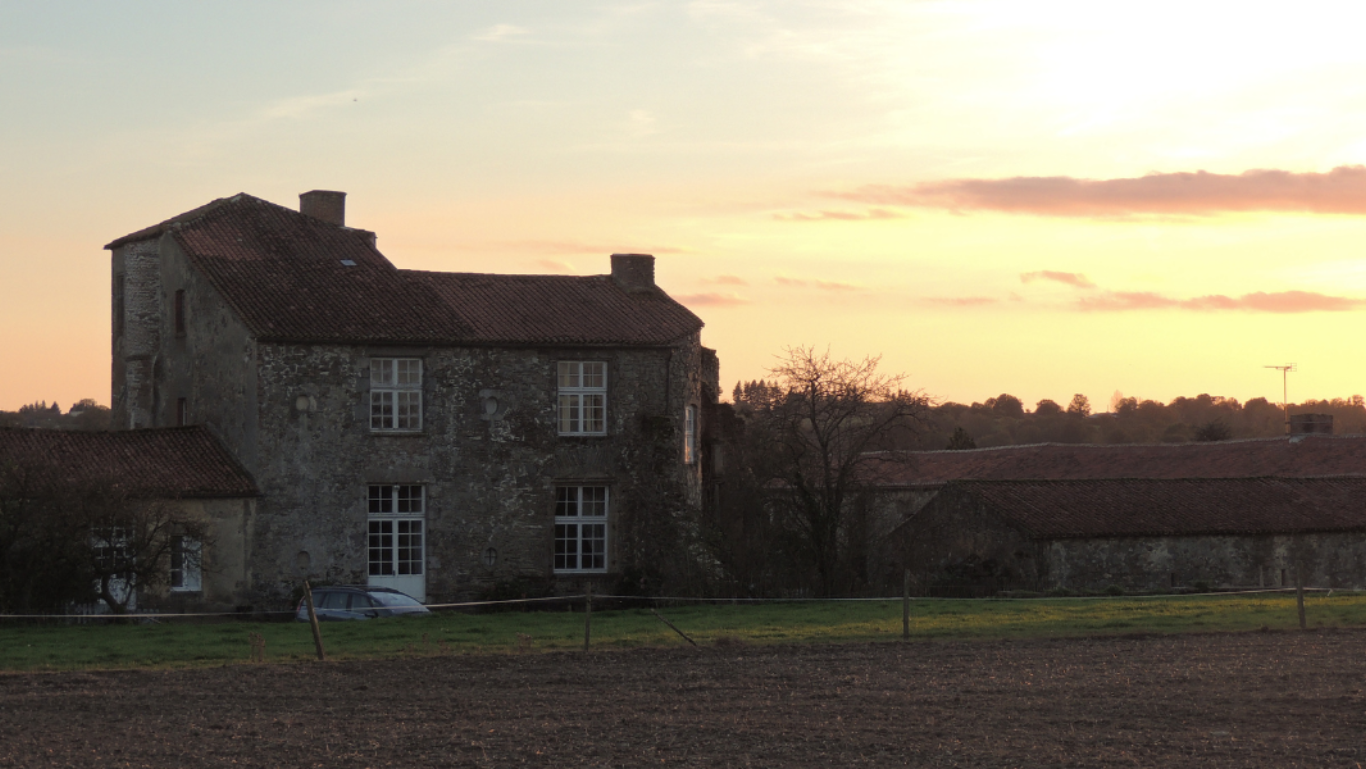
A qui s’en sera enquis, Il faudra qu’on réponde :
Voici une métairie, dans la Vendée profonde.
“Une métairie dites-vous ? plutôt une seigneurie”
Eh oui, c’était les deux, du temps que les seigneurs
N’étaient pas à Versailles à chercher les honneurs.
Nous sommes dans le bocage, c’était un vieux château.
Les ans, et puis les guerres, la pluie, les incendies
Rabattirent sa fierté. Il tomba dans l’oubli.
Longtemps il attendit que cessent tous ces maux.
Le Puy du Fou, Maillezais, La Chabotterie, Fontenay
Tour à tour se relèvent, tour à tour se réveillent.
Usant ses dernières forces, la Ménardière aussi
Humblement se redresse et doucement reprend vie.
Ses roches de granit couvertes de châtaignes
Regardent vers le sud, vers l’ombre du dolmen
(Qui rappelait qu’ici toujours on y vécut).
Le chemin de Saint Pierre, la vieille voie romaine,
Tout au fond de sa terre est creusée dans les haies.
Et dans le petit bois, le long de l’avenue,
Dans les douves qui baignent les murs du domaine,
Dans l’enceinte de la cour, tout près du puits profond,
On chasse le chevreuil, on pêche les gardons,
On cueille les framboises, les roses et les groseilles
Comme aux temps les plus doux, comme au temps des merveilles
Murs de dur granit à sculptures médiévales,
Escalier, monument que l’on monte à cheval
Voûtes richement sculptées et portes dérobées,
Coffre cerclé de fer et porche pigeonnier,
Cheminées crépitantes et armoires profondes,
Dans les chambres, une alcôve ou bien un baldaquin
Les volutes d’un berceau aux voilages anciens.
Dehors, hérons et chouettes, grenouilles et étourneaux
Pépiement de l’alouette et cloches qui répondent
Bruissement de la source qui rejoint le ruisseau.
Et puis l’allée de hêtres : genêts et digitales
Couvrent le sol pierreux de milliers de pétales,
Plus loin, l’ancien lavoir, la tour du vieux clocher.
Enfin la vieille légende du trésor oublié…
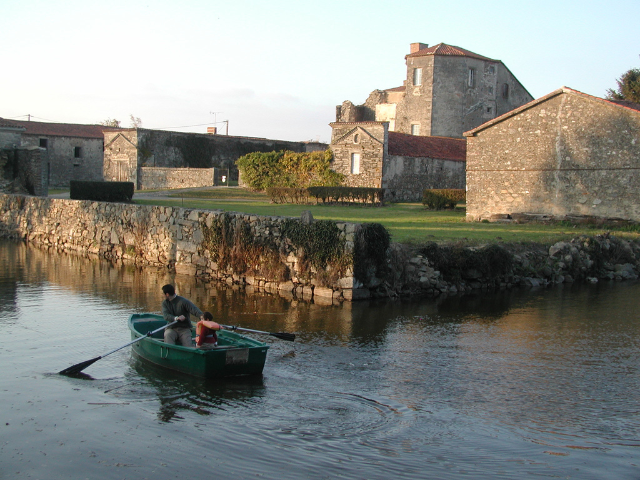
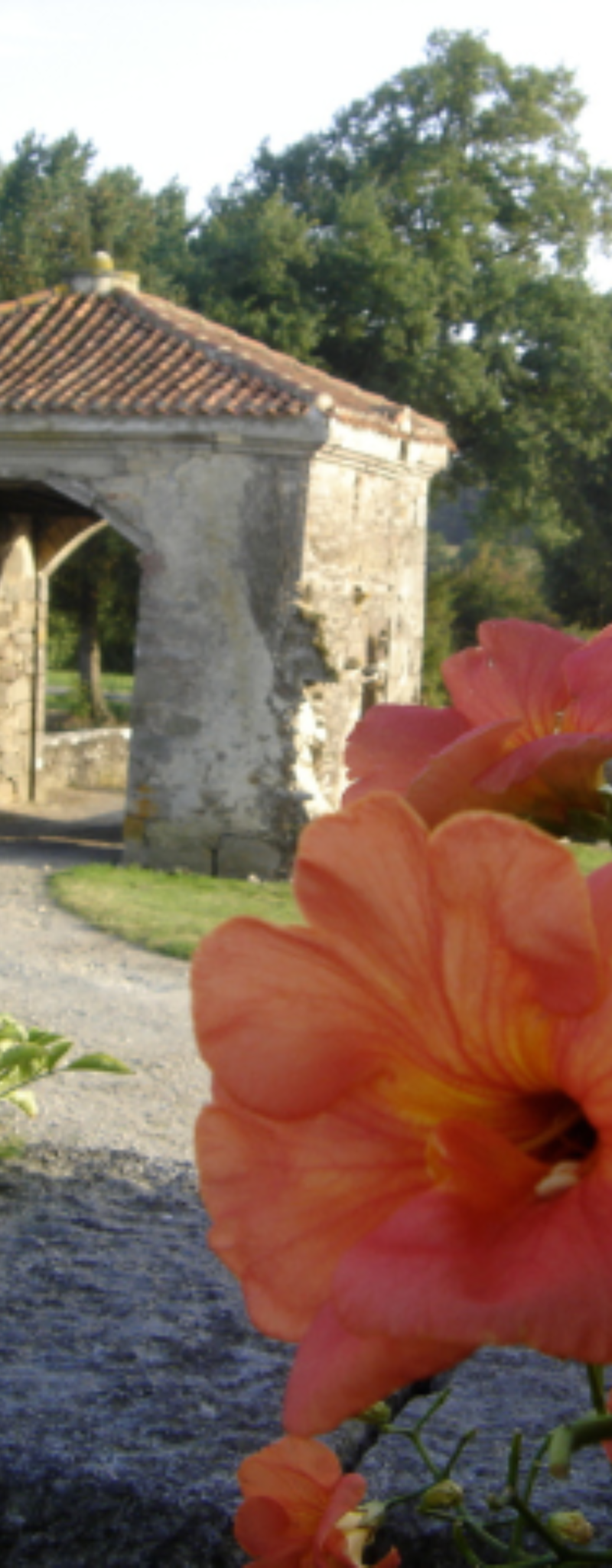
Histoire du château

Excepts from De Châteaux en Logis
Chronology of Families of the Vendée Region
Archives of Guy de Raigniac Tome VI
Bonnefonds Editions
pgs. 50 –57
A large octagonal tower, with a sumptuous Renaissance stairwell on the interior, a feudal residence partially in ruins and a small entrance way leading to the courtyard – that’s about all that is left of the former Mesnardière chateau.
The Mesnardière was practically always a home to important and wealthy families up until the French Revolution. At that time it must surely have been one of the most beautiful homes in this part of the Vendée region. The Mesnardière was most likely founded by the Mesnards, dating just prior to the 14th century. Whenever it was precisely, the first Lords of the Mesnardière residence were the Grignons. They founded several other residences bearing their name “Grignonnière.” Very quickly, these residences passed into new hands. It is possible that a member of the Grignon family married a member of the Mesnard family, inheriting the Mesnardière.
However, there are no documents to substantiate this hypothesis. We only know that around 1403, André Grignon, son of Jean Grignon, already Lord of Breuil Batard in Tardière, was the Lord of the Mesnardière.
What is known for certain is that the last Grignon at the Mesnardière was François Grignon. He was murdered circa 1529 by Gilles and Jacques de Faubert, Lords of Vergne in Secondigny.
François Grignon was the father of a daughter (Catherine) already married for several years to Louis Bigot. His attackers were two young men: Jacques de Faubert, born in 1509 and only 20 years old; Gilles, his older brother, was already in the service of the King. Following their arrest on October 26th, 1531, Gilles and Jacques de Faubert were condemned to be beheaded and their property was to be confiscated.
The sentence was given in absentia and was then rapidly followed by letters of clemency. In the end Gilles and Jacques de Faubert kept their heads and their property. We can only hope that they paid the 4,000 pounds owed to François’ heirs, as Catherine Grignon was already deceased by that time.
All evidence inclines one to believe that François Grignon had the Mesnardière tower and stairwell built. The coats of arms of the Grignons are plentiful and noticeable.
Thus, the new Lords of the Mesnardière were the Bigots. Louis Bigot, the widower of Catherine Grignon since 1531, descended, if not from the Visigoth kings as some geneologists suggest, at least from the mayor of Poitiers in 1372. His family was rich. Moreover, they owned the Girardie fief in Sérigné, where they built a very beautiful residence.
The Mesnardière was passed onto their second son François Bigot. He was catholic and the head of a group to enforce the ordinances of King Charles IX. In May 1574, he laid siege to the chateau of la Foret-sur-Sèvre, occupied by Protestants. On their end was his son-in-law, René Batard of the Cressonnière. The Protestants appeared to be outnumbered and willing to surrender. Francois Bigot came to negotiate with them. He was killed. His body was found between the two bridges of the chateau and the murder was considered “against all rules of war.”
We will not go into any accusations as to whether René Batard had wanted to have his father-in-law killed or not.
René was eager to have him out of the picture and had reproached him for having left the Girardie to his youngest daughter, Anne. His own wife, Charlotte Bigot, was the oldest of two sisters to whom he felt her father should have given both the Girardie and the Mesnardière. On November 7th, 1579 René Batard was sentenced to death by the Court de Grand Jours of Poitiers. The sentence ordered that the Mesnardière chateau and that of the Cressonnière, both belonging to René Batard, be razed. Only two years later, René Bastard was killed in combat near Richelieu.
The Mesnardière would be, up until the Revolution, the principle residence of the heirs of René Batard. The latter were rich and powerful characters. His son, Henry Batard, served King Henri IV loyally. He became a knight in the Order of the King and the Governor of Maillezais. His wife, Louise de Pontlevoye, brought him the charming chateau of the Blandinière, near Mauléon as well as other properties.
But the Batards remained Protestants and in the following generation, the two sons of Henry Batard would follow Soubise in his revolt against Louis XIII. The oldest was killed in the battle of Mareuil.
The Mesnardière and the largest part of the Batard family inheritance went to the oldest daughter Louise. Like the majority of her brothers and sisters, she was born in the Mesnardière. She married Louis Maistre who was the Lord of Papinière and of Aizenay.
Their descendants, the Maistre then the La Tour also lived in the Mesnardière. In 1734, their heir, Henriette-Catherine de La Tour married Louis-Henri d’Asnières, Lord of Lucques. He was a neighbor who lived in the small Lucques chateau at the outskirts of Menomblet and Saint-Marsault. These few things near the Mesnardière and the d’Asnières would from then on stay in the Mesnardière.
Their son Jean d’Asnières found himself to be in charge of a considerable fortune. He obtained d’Asnières-La Chataigneraie, from his lands the small chateau of Vouvant, the Chataigneraie, the Mesnardière, Saint-Pierre-du-Chemin and Menomblet.
Jean d’Asnières married Mademoiselle Catherine de Montmorin in 1784. The lived in the Mesnardière where their children were born. The French Revolution was going on and Jean d’Asnières emigrated. His wife and children first lived in the Mesnardière and later retired to Normandy.
The chateau was set ablaze at the time of the Colonnes Infernales (the hated military flank known for its violence)
All of Jean d’Asnières’ land was confiscated as the property of emigrants. They were adjudicated the 9 April (“Pluviose” on the contemporary calendar), in the fourth year of the new Republique.
Thankfully a frontman, Catherine Arnaude de Montmorin, wife of Jean d’Asnières, had the right to repurchase the chateau. Thus, the Mesnardière returned to the d’Asnières family. They proceeded to make several summary repairs for the occasional stay at the chateau, but in general they lived in Paris.
The last of the d’Asnières to own the Mesnardière was Count Raymond d’Asnières who married Mademoiselle Morin de Banneville. She died a widow in 1881. She founded a hospital in Saint-Pierre-du-Chemin and was buried in its chapel, along with her husband. The bodies of her in-laws were also taken there.
The Mesnardière was bought in 1869 by Edmond Savary de Beauregard, of the Chastenay branch in La Chataignerie, who was interested essentially in property which was not surrounded or inhabited by his family or its descendants. The chateau passed through inheritance to the La Barre de Nanteuil family and then to the du Plessis de Grenedan.
It was not restored until 1998.
Architectural Description
In 1997 the octagonal tower of the stairwell in the Mesnardière was the only element still inhabitable amidst the ensemble of more important buildings, of which only vestiges remained. Protected by its inclusion in a supplementary inventory of historical monuments of the Vendée region, on account of its unique, flamboyant architecture, this superb stairwell suggests by its grandeur the former prestige of this residence.
The old plans, the common dimension, the surface of the cellars, the architectural details: all reflect this richness.
The destruction suffered at the end of the 16th century and the redevelopment carried out in the 17th century required a change to the entrance to the tower by favoring instead a more direct route. The porch and the two lateral pavilions gave the ensemble of buildings a modern flavor.
THE TOWER : THE MOST INTERESTING AND RESTORED ELEMENT
This tower is the most beautiful example of flamboyant architecture in the Vendée region.
Large in scale (the length of the steps reaches 2.5 m.), the spiral of the granite stairwell develops on two levels. It ends with a very beautiful, sculpted railing.
Above the stairwell is a room which one reaches by way of a small adjunct tower stairwell constructed in somewhat thick masonry consisting especially of brick. This room whose upper part is now lowered is embellished with a beautiful granite chimney from the 15th century. The small staircase continues for a few steps, reflecting the destruction of the former floor above.
The landings on the first floor and the second floor have arches with ornate diagonal rib arcs and sculpted keystones.
THE REMANANTS OF THE 18th CENTURY
Profound transformations in the 18th century completely changed much of the original layout :
the current principal access to the chateau was aligned with the tower along the basis of :
the creation of an entry avenue to the chateau
the construction of an entrance to the courtyard
the reduction of the once large courtyard with the construction of two small buildings ending at the triangular pediment
Consequently the flamboyant door leading to the interior staircase was filled in and replaced with a new, central doorway. Above which a new window was created and an old one was filled in.
